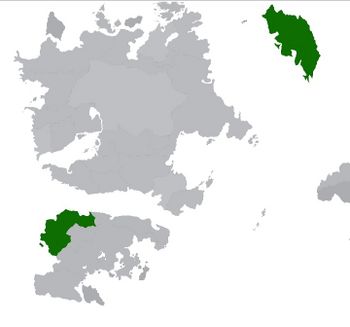Grand Duchy of Reykanes
Grand Duchy of Reykanes | |||||||||
|---|---|---|---|---|---|---|---|---|---|
 Kingdom of Salisford with Reykanes in 1810 | |||||||||
| Status | Grand Duchy within the Kingdom of Salisford | ||||||||
| Capital | Hafnir | ||||||||
| Common languages | Reykani, Salisfordian | ||||||||
| Religion | Savottan Catholicism | ||||||||
| Government | Monarchy | ||||||||
| Grand Duke | |||||||||
• 1781-1792 | Cesario I (First) | ||||||||
| Governor-General | |||||||||
• 1781–1801 | Mariano Lombardo (First) | ||||||||
• 1910–1949 | Alfonso Broddason (Last) | ||||||||
| History | |||||||||
• Established | 1781 | ||||||||
• Communist revolution | 1949 | ||||||||
| Currency | Reykani lira | ||||||||
| |||||||||
| Today part of | Reykanes | ||||||||
The Grand Duchy of Reykanes (Reykani: Stórhertogadæmið Reykjanes; Salisfordian: Granducato di Reicania) was a predecessor state of modern Reykanes. It existed between 1781 and 1800 as an independent state and then from 1800 to 1949 as an autonomous part of the Kingdom of Salisford.
Preceeded by the Reykani Commonwealth, the Grand Duchy was created in 1781 following the ousting of the usuper Ástþór Vífilsson by the estates of Reykanes and the invitation of the Salisfordian King Cesario VI. The Grand Duke of Reykanes was the King of Salisford, represented by the Governor-General. Originally acting as an independent state ruled by the Salisfordian monarch in personal union, it was officially integrated into Salisford as an autonomous region following the restoration of the Salisfordian monarchy and end of the Salisfordian Revolution in 1800.
Following waves of assimilation, the Grand Duchy's autonomy would grow over time.
From the growing resistance in the 1940s lead to a revolution that resulted in the Reykani Declaration of Independence and the end of the Grand Duchy.
History
Vífilsson's takeover
At the end of the 18th century, Reykanes was weak and fragile nation.
Invitation to the Salisfordian King
Beginning of the Grand Duchy
Salisfordian Revolution
Integration with Salisford
Salisfordianization
Industrial Revolution
Reform Period
Communist revolution
The Reykani Revolution of 1949, also known as the Utanvegar War, was a countrywide revolution against the government of the Grand Duchy of Reykanes (1781-1949). It began on January 3, 1949, when a workers' strike in Laugleós escalated into a full-scale revolution after clashes with the military police. Militias also formed to fight against the Grand Duchy. The revolution lasted five months, resulting in the defeat of the Salisfordian-backed Grand Duchy and the victory of the communist faction.
Government and politics
The Grand Duchy of Reykanes was a colony of the Kingdom of Salisford and maintained an administration roughly modeled on the Salisfordian government. The Charter of the Grand Duchy formed the constitutional basis of the colonial government and detailed how the territory should be governed and organized.
The Salisfordian monarch ruled as the Grand Duke of Reykanes and was represented in Reykanes by the Governor-General. Executive power was highly concentrated with the Governor, who confirmed all non-noble members of the House of Peers and also served as overall president of the entire Reykani Diet. The Salisfordian government provided oversight for the colonial government and the Sovereign held sole authority to amend the Charter of Reykanes.
Provinces
Flags
Military
Salisfordian military served the protection of the Grand duchy on average, however due to long distances, a special army was created to serve as the de facto army of Reykanes. They were mostly stationed near the main cities in the south rather since they were strategic key points rather than in the unpopulated heart of the island.
Historical population of the Grand Duchy
- 1810: 1,793,000
- 1890: 1,913,000
- 1920: 2,148,000


